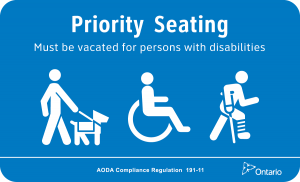On this page

The Accessibility for Ontarians with Disabilities Act 2005 (AODA) became law on June 13, 2005. The legislation mandates how businesses and organizations provided accessible services to people with disabilities. The Integrated Accessibility Standards Regulation (IASR, 191-11) established under the Accessibility for Ontarians with Disabilities Act and adopted in June 2011, includes 80 accessibility standards relating to transportation, employment and information and communications.
Section 49 of the Integrated Accessibility Standards Regulation requires that every conventional transportation service provider ensure that there is clearly marked seating for persons with disabilities on every vehicle, located as close as practicable to the entrance door. The signage must indicate that passengers other than those with disabilities must vacate the marked area if it is required by a person with a disability.
Priority seating
Priority seating is for the use of passengers with a disability. These seats are located close to the front of the vehicle. Customers are expected to respect and obey the purpose of the designated seating area, which means: if you are sitting in one of these designated seats, you MUST vacate the seat for a passenger with a disability. Bus drivers will not enforce this requirement or intervene in any dispute related to Priority Seating.
The provision of priority seating on all conventional transit vehicles has been mandated as part of the Accessibility for Ontarians with Disabilities Act 2005 (AODA) accessibility standards requirements.
Courtesy seating
Courtesy seating is intended to provide additional seating for people who will benefit from having a seat near the front of the vehicle including:
- Seniors,
- expectant mothers,
- adults traveling with infants or small children, or
- any other passenger who may benefit from a seat.
If you are sitting in one of these designated seats, please respect its purpose and give up your seat to those who need it. Bus drivers will not enforce this requirement or intervene in any dispute related to Courtesy Seating.
AODA and Priority Seating
The Accessibility for Ontarians with Disabilities Act 2005 (AODA) became law on June 13, 2005. The legislation mandates how businesses and organizations provided accessible services to people with disabilities. The Integrated Accessibility Standards Regulation (IASR, 191-11) established under the AODA and adopted in June 2011, includes 80 accessibility standards relating to transportation, employment and information and communications.
Section 49 of the IASR requires that every conventional transportation service provider ensure that there is clearly marked seating for persons with disabilities on every vehicle, located as close as practicable to the entrance door. The signage must indicate that passengers other than those with disabilities must vacate the marked area if it is required by a person with a disability.
Important to remember
A person with a disability occupying a Priority seat is not required to move for another customer with a disability. Use of these seats is on a first come-first served basis.
You are not required or expected to leave a transit vehicle in order to make room for a customer with a disability.
Bus drivers will not enforce this requirement or intervene in any dispute related to Priority Seating or Courtesy Seating. We ask, however, that you respect this designated seating area and show consideration for those whose need is greater than your own.
Frequently asked questions
Why are there both Priority Seating and Courtesy Seating areas on a bus?
The Priority Seating area is a regulatory requirement under the Accessibility for Ontarians with Disabilities Act. The Courtesy Seating area is provided in addition to the Priority Seating area for passengers who may benefit from a seat, but do not have a disability.
I am a passenger with a disability. What do I do if the Priority Seating area is full when I board the bus?
Politely remind the customers seated in the Priority Seating area of its intended use and ask that they make room for you.
What do I do if the passengers seated in the Priority Seating area refuse to move for me?
Please remember that passengers in the Priority Seating area may suffer from a disability that is not easily recognized by others and they may not be comfortable discussing it in public. If the passengers in the Priority Seating area do not move when requested, proceed to the Courtesy Seating area to find a seat.
The Priority Seating decal states that other passengers MUST vacate for a passenger with a disability. If someone refuses to move for a passenger with a disability, who will make them obey the sign?
The wording on the decal is a legal requirement under Regulation 191-11 but the Regulation does not provide any reference to enforcement. Given the vast number and varying degree of disabilities, many of which are invisible, it would be extremely difficult for a third party to determine who is more entitled to the Priority Seating area. As such, we expect customers to do the right thing.
Can I ask the operator to force passengers to vacate a seat for me?
Drivers/operators will not intervene in a dispute between passengers regarding a seat.
I am a person with a disability. When I board a bus which is full and people are both seated and standing in the Priority Seating area, do other passengers need to vacate the bus to make room for me in the Priority Seating area?
No. Public transit is first come, first served. Other passengers who have paid a fare are not expected to vacate the bus to make room for other passengers. If you are not comfortable completing your trip without a seat, please wait for the next bus.


